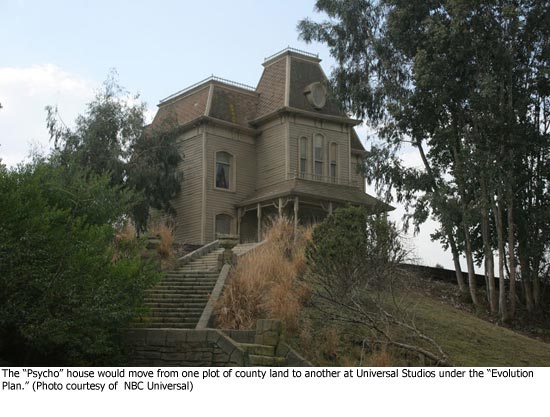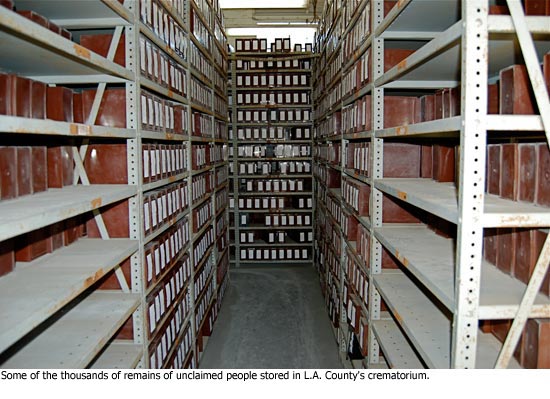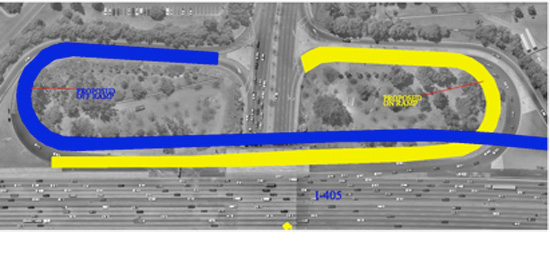Learning some new lines at Universal
December 9, 2010
Norman Bates is planning a road trip.
Universal Studios’ “Psycho” house and the Bates Motel will be spooking tram-riders from new locations on the Universal lot if plans for a major new 2,937-unit housing development on the site are approved. Also hitting the road (or cul de sac, as the case may be) are Wisteria Lane of “Desperate Housewives” fame and Falls Lake, where movies ranging from “Jaws” to the upcoming “Pirates of the Caribbean 4″ were shot.
But those high-visibility locales aren’t the only places that will be getting an Earthquake Ride-sized shake-up if the $3 billion, 20-year development known as the NBC Universal Evolution Plan goes through.
Jurisdictional lines that now cut through the property, unseen by the naked eye but crucial to delivery of public services, also are set for a retake.
The 391-acre property currently is divided between Los Angeles County (with 296 acres) and the City of Los Angeles (95 acres.) Some buildings on the Universal lot now are literally split between the two jurisdictions, as is the pedestrian shopping-and-dining mall CityWalk.
Thus, munching a hot dog at Jody Maroni’s Sausage Kingdom places you in city territory, but sipping a margarita at Camacho’s Cantina lands you in unincorporated L.A. County. Shoppers at Billabong and the Dodgers Clubhouse store are browsing through the city, but anyone taking in a movie at AMC Theatres has entered the county zone. The big Universal globe at the theme park entrance? That’s in the city, as is the Zen Zone’s Oxygen Bar (which, at least for visiting out-of-towners might seem to have a certain only-in-L.A. logic to it.)
The new plan proposes to redraw the lines so that all of CityWalk and the entire Universal Studios theme park would fall squarely into county territory while the new housing development would reside completely within the city limits. The city and county would share equally in the project’s economic benefits, NBC Universal executives say, adding that the idea of redrawing the jurisdictional lines is to keep related functions together and under the same governmental system.
That means relocation for the “Psycho” house, Bates Motel, Wisteria Lane, Falls Lake and other facilities, including the NBC Universal employee childcare center. All except the childcare center are now in county territory but will need to be relocated to other unincorporated county land on the lot to make way for the proposed residential development.
Because the plan will require changing jurisdictional boundaries, it will require approval from the Local Agency Formation Commission for the County of Los Angeles (LAFCO.) That vote is expected to come at the end of a lengthy review and public comment process, and a series of official actions including votes by the county Board of Supervisors and the Los Angeles City Council, which will need to approve the housing component of the plan.
With the release of the project’s draft Environmental Impact Report last month, the initial round of public comment is underway, with a meeting scheduled for 4 p.m. on Dec. 13 at the Universal Hilton. The public comment period on the massive, draft EIR (which weighs in at 39,000 pages, including supporting documents) has been extended to Feb. 4, 2011, at the request of Supervisor Zev Yaroslavsky and City Councilman Tom LaBonge.
“NBC Universal’s proposed project is a massive undertaking and it is vital that the involved Planning departments provide ample opportunities for potentially-affected residents to participate in this important public process,” Yaroslavsky said in a Nov. 5 letter requesting the extension.
(The agenda for the Dec. 13 meeting is here. This city Planning Department document also has information on the meeting and how to comment on the draft EIR.) More opportunities for the public to weigh in on the overall project will take place once a final EIR is prepared.
Among the “significant and unavoidable impacts” raised by the draft EIR are traffic and air quality, and, during the construction period, solid waste removal and noise. Neighbors of the project already have expressed concerns. Daniel Savage, president of the Hollywood Knolls Community Club, said his organization is worried about the local impact of the proposed residential development and especially about the potential for worsening traffic in the area.
“We’re not unilaterally against the concept of some kind of development,” Savage said. “We do recognize the right of NBC Universal…to develop their own property. But it can’t be at the expense of their neighbors.”
The project’s website devotes a page to proposed transportation improvements to help mitigate potential problems. Still, Savage, who said his own group is in the midst of a “deep dive” into the project’s traffic study, expressed some early reservations about how those measures would work out—and for how long.
As for the annexation of land, the county stands to lose a net 44 acres to the city under the plan. (For those keeping score at home, that’s 252 acres for the county, 139 acres for the city.) NBC Universal executives say the end result—if approved by LAFCO—would be a fair and sensible division.
“Realigning the jurisdictional boundaries allows us to effectively align property uses with the goal of equitably sharing the economic benefits that the Evolution Plan brings,” Tom Smith, NBC Universal’s Senior Vice President of West Coast real estate, said in an emailed statement.
“This will allow the City and County to equally benefit from the $2 billion in new economic activity and the $26 million in new tax revenue generated by the project.”
Smith said NBC Universal believes the city is “best equipped to fill the public service needs of the new residential community,” while the county, with a long track record of serving the studio and theme park, “is best able to continue doing so.” NBC Universal headquarters would remain in county jurisdiction under the plan.
“The majority of the project remains within the County,” Smith said, “and NBC Universal will continue to be a major employment and economic engine as a result of this project.”
In addition to the new housing, the project would add a new 500-room hotel right at the entrance to the theme park as part of 1.83 million square feet of new entertainment, studio and office space planned for the site. An additional 115,000 square feet would be devoted to “neighborhood-serving retail/commercial uses” for the new residential development and up to 65,000 square feet of “community-serving uses.” (This interactive map provides more details of what’s being proposed.)
CityWalk would get a new sheriff’s station, under the plan. A new additional fire station or upgraded county fire station also is proposed, along with a new city fire station located in the city to serve the residential community. And 35 acres of new open space, including parks and trails, would be set aside.
Posted 12/9/10
A farewell to the lonely
December 9, 2010
Before dawn on Tuesday, the sad ritual began.
For ten straight hours, two veterans of L.A. County’s crematorium and cemetery solemnly filled a wide and deep grave with small plastic boxes containing the ashes of people whose bodies had gone unclaimed for more than three years. Back and forth the two men walked between the jam-packed storage shelves of the crematorium and the small cemetery just beyond its doors.
In all, they would respectfully and neatly stack 1,689 boxes in the ground. On the grave marker, there would be no names, no chiseled tributes to the deceased as being anyone’s beloved mother, father, husband or wife. The small stone would simply state the year of their passing—2007.
The core mission of Los Angeles County government is to provide for the poor and disadvantaged among us. We are their safety net—sometimes even in death. Over the decades, the county has buried the remains of thousands upon thousands of people whose bodies have gone unclaimed. Some of them, mostly the younger ones, may have died violently. Others lived long but, at the end, had no enduring ties and no one to grieve for them.
 So we, the people, give them the dignity they deserve in a graveside service east of the Civic Center, near County-USC Medical Center, the public hospital where a good number of them spent their final days.
So we, the people, give them the dignity they deserve in a graveside service east of the Civic Center, near County-USC Medical Center, the public hospital where a good number of them spent their final days.
For years, my colleague, Don Knabe, has reminded us during board meetings of these upcoming services, asking for a moment of silence to honor those who’ll soon be sharing a final resting place. This year was no different for Don, although the results were; a large media contingent showed up for the first time. I’m not sure why, but I’d like to think that, in these dire economic times, there’s a growing awareness of and empathy for those who are hurting.
“Their life was significant and important,” Father Chris Ponnet, director of spiritual care at County-USC, told this week’s gatherers. Prayers were read from Christian, Jewish and Islamic scriptures. These ceremonies, Father Ponnet said, “are a sign that society does not just throw away people just because they are unknown.”
“The blessing,” he said, “is that the county holds these services. The tragedy is that these people were disconnected from their families in the end.”
Our county aims to be one in which no single life is valued more than another, no matter what their lofty or lowly social status. This year, as I gather with family and friends to share the spirit of the holiday season, I’ll remember those 1,689 souls and be grateful for the many blessings in my life.
Posted 12/9/10
Wilshire 405 flyover ramps coming
December 8, 2010
Given the dismal state of Westside traffic, it’s been a long time since anybody was able to fly through the intersection of Wilshire Boulevard and the 405.
But someday people will be able to fly over it.
Two new flyover ramps are part of an ambitious new phase of the 405 Sepulveda Pass improvements project that’s currently projected to begin as early as February. The usual no-pain-no-gain equation applies, however, and each of the existing Wilshire ramps is expected to be closing for periods that could range from 14 days to three months so the work can take place. Detours and many other details of the construction still are being worked out.
The work promises to bring a new layer of temporary suffering to an area that already experiences some of the region’s worst traffic.
When completed, the new ramps, or loops, are expected to significantly improve the flow of traffic onto and off the freeway. Currently, vehicles trying to get off the freeway onto Wilshire must jockey with other vehicles entering the freeway. Under the new configuration, shown in the graphic below, the on ramps and off ramps would be completely separate.
The Wilshire flyover ramps have been the subject of previous speculation, including this on LA Observed. The plans will be sketched out for the public, among many other matters, at the project’s quarterly community meeting on Thursday, Dec. 9, from 6 p.m. to 8 p.m. in the Mirman School auditorium.
An overview of the Wilshire improvements also was included in last month’s Community Advisory Committee briefing, which is available here and will be repeated for anyone who’s interested at the end of the meeting on Thursday.
The Sepulveda Pass project will add a 10-mile northbound carpool lane to the 405 and rebuild three overpass bridges, along with other improvements. It is expected to be finished in 2013.
Posted 12/8/10
Top county doc wants lap band ad probe
December 8, 2010
L.A. County’s top public health official wants to put the squeeze on those ubiquitous LAP-BAND ads.
In a Dec. 7 letter to the U.S. Food and Drug Administration, Dr. Jonathan E. Fielding asks the agency to investigate whether widespread promotion of the LAP-BAND by the 1-800-GET-THIN weight loss clinics is misleading the public by failing to disclose enough about the potential risks of such surgery.
Fielding, the county’s director of public health, said while bariatric surgery can be appropriate for some severely obese patients, it’s not for “the vast majority of individuals, and should be reserved for those who have failed other approaches.”
He also took aim at the assertion in the advertising campaign that “Diets fail!” which he said undercuts the importance of healthy, common-sense lifestyle choices.
“Misleading advertisements erode the ability of the majority of the public, who are currently either overweight or obese, to fairly consider alternative weight management options, and for ‘normal’ weight individuals to be concerned about behavior that increases risk of weight gain,” Fielding said in the letter.
Fielding’s letter comes as Allergan, which manufactures the LAP-BAND system, is seeking approval to broaden the use of its product by allowing less obese people to use it. Lowering the standards to include people with a body mass index of 35, or 30 if they have other conditions, could mean more than 2 million people in L.A. County would be eligible for such surgery, Fielding said. Currently, most patients must have a body mass index of at least 40, or 35 with certain other conditions, or be more than 100 pounds overweight, to be considered eligible for LAP-BAND surgery.
An FDA advisory panel last week voted in favor of the proposed expansion to less obese patients.
Anyone who’s driven or watched television in Los Angeles County has likely seen the billboards and bus ads touting LAP-BAND and heard the 1-800-GET-THIN jingle. A sampling of the ads were included with Fielding’s letter to the FDA.
Misleading promotional messages, especially if the device becomes available to more people, may prove to be a disincentive to maintaining a healthy lifestyle because they create the “false impression that there is a very simple, fast, effective and permanent fix” for weight loss, Fielding said
In an interview, Fielding said one purpose of his letter is to have the FDA clarify who bears responsibility for fully disclosing any potential risks associated with a medical device.
A spokeswoman for Allergan said her company had no role in the billboard and current TV advertising campaigns. “Allergan doesn’t control, manage or have any input on those ads,” said spokeswoman Cathy Taylor, who said her company would not comment on others’ promotional efforts involving the device.
Representatives for 1-800-GET-THIN could not be reached.
Fielding’s letter was directed to Dr. Herbert Lerner, acting director of the FDA’s Reproductive, Gastro-Renal and Urological Devices Center for Devices and Radiological Heath.
Fielding urges Lerner to take steps to ensure that the LAP-BAND promotional campaign “does not constitute misbranding of a restricted device.”
Fielding is not alone in voicing concerns about the potential expansion of the device’s use. Others, including the National Women’s Health Network, a nonprofit advocacy group, and the National Research Center for Women and Families also have raised questions. Before voting in favor of the proposed expanded use for the LAP-BAND, the FDA advisory panel heard testimony from New York attorney Stephanie Quatinetz, whose 27-year-old daughter died after LAP-BAND surgery.
Posted 12/8/10
Coliseum rave continues—with strings
December 2, 2010
Responding to wide concerns over the safety of raves, the Los Angeles Memorial Coliseum Commission this week told event promoters they must seek the panel’s approval at least 60 days before their next scheduled show at the historic facility.
The commission action came in lieu of reinstating a ban on the highly popular electronic music festivals that was put in place after the overdose death of a 15-year-old girl at last June’s Electric Daisy Carnival at the Coliseum. The two-day event, which drew 185,000 fans, prompted emergency medical officials to call for an end to the shows because of the high numbers of Ecstasy-related drug overdoses.
Following the girl’s death, the nine-member joint county, city and state commission adopted a moratorium on raves, proposed by County Supervisor Zev Yaroslavsky, a member of the panel. Yaroslavsky on Wednesday proposed that the board require the Coliseum staff and Electric Daisy Carnival promoter to seek the commission’s approval at least 60 days before the next show in June.
The commission will examine plans to ensure the safety and health of attendees. Many of those measures are detailed in a series of recent recommendations by the county’s public health department.
The commission will also study the impact of the festival in determining how to move forward. “If we can’t control it,” Yaroslavsky said, “then the promoters are going to have to find another place.”
On Tuesday, the Board of Supervisors is expected to vote on a motion by Yaroslavsky and Supervisor Don Knabe to adopt the series public health department recommendations, the product of a multi-jurisdictional task force.
You can read more about the Coliseum Commission’s action in these accounts from the Daily Breeze and the Los Angeles Times.
Posted 12/2/10
Sundays Live at LACMA features Beethoven and Schubert
December 2, 2010
 This weekend, the long-running “Sundays Live” series of live broadcast performances presented at the Los Angeles County Museum of Art offers pianist Inna Faliks performing Beethoven’s Sonata No. 17 in D minor (popularly, but spuriously, known as “The Tempest”) and Schubert’s Sonata in A minor.
This weekend, the long-running “Sundays Live” series of live broadcast performances presented at the Los Angeles County Museum of Art offers pianist Inna Faliks performing Beethoven’s Sonata No. 17 in D minor (popularly, but spuriously, known as “The Tempest”) and Schubert’s Sonata in A minor.
These weekly chamber music concerts and recitals, free to the public with no reservations required, feature some of the leading classical artists from Southern California and throughout the world.
They can be seen, and heard, Sunday nights at 6 p.m. at LACMA’s Bing Theatre, 5905 Wilshire Blvd. in the Miracle Mile. Here’s the schedule of upcoming performances.
Posted 12/2/10
A glimmering night at Disney Hall
December 2, 2010
Along with food and drink, the winter holiday season traditionally offers a feast of another kind: a vast array of festive music, dance and arts offerings in public and private venues throughout the Southland.
Among the treats on offer, the Music Center’s Walt Disney Concert Hall proudly presents guest conductor Stéphane Denève and pianist Nicholas Angelich in a program of Beethoven’s celebrated “Emperor Concerto” and Debussy’s Ibéria, as well as the West Coast premiere of a work by the modern classical composer Guillaume Connesson, Une lueur dans l’âge sombre (“A Glimmer in an Age of Darkness.”)
The concert takes place on Friday, December 3. Disney Hall is located at 1st and Grand downtown. Ticketing information is here, and directions and parking information here.
Posted 12/2/10
How to book brighter future for libraries
December 2, 2010
Los Angeles County’s top librarian, Margaret Donnellan Todd, was worried about the city of Bell. Would public disgust with the salary scandal there impact the library system’s efforts to shore up its depleted finances?
The answer: “People are not mad at the libraries,” she says. “They’ve separated us from the rest of what people think about government in general now.”
That bit of much-welcomed news came during an unprecedented effort by the County Public Library to determine its long-term financial strategy at a time when its budget is strained and shrinking. The analysis, conducted by Godbe Research, showed that the public puts a premium on local libraries and would be willing to pay a special tax to keep them viable.
Based on Godbe’s research, which included extensive polling, the Library Commission this week recommended to the Board of Supervisors that the county begin aggressively examining the possibility of asking voters to pass a special parcel tax measure, which would generate millions of dollars annually. The commission also recommended that recent cuts to the library’s budget be restored.
Godbe, which was paid $42,000 for its work on behalf of the library, concluded that such a tax measure—“the only viable option”—could win the required two-thirds majority needed for passage if the amount was not too high.
Currently, unincorporated areas of the county pay a special parcel tax of $27.84 to support the libraries, as do 11 cities that opted into the library district. County libraries exist in other municipalities but residents there do not pay the parcel tax. As a result, those branches do not receive the same level of services.
Under the Library Commission’s proposal, the parcel tax, if approved, would be expanded across the Los Angeles County public library service area, more than doubling the number of parcels currently assessed with the tax.
County Librarian Todd says the document filed this week with the board provides a solid foundation to begin moving forward. She says she hopes to have Godbe conduct more polling in the spring to further gauge the mood of voters and their receptivity to a ballot measure.
“It’s important for our communities to know that this is a process,” she says, “in how to position our department for the 21st century.”
Posted 12/2/10
Hepatitis A alert for deli patrons
December 2, 2010
Public health officials are urging shots for anyone who ate a sandwich from Jerry’s Deli in Westwood on certain dates in November, after an employee there came down with hepatitis A.
The dates are November 18, 21, 23 and 24. The public health department said those who may have been exposed should get an immune globulin shot or a hepatitis A vaccination no later than 14 days after their exposure to prevent or reduce illness.
People who ate food other than sandwiches aren’t considered to be at risk. Only the Westwood branch of Jerry’s Deli is affected.
Affected diners should contact their personal physician promptly about getting a shot. If that’s not possible, immune globulin and hepatitis A vaccine are also available at some county clinics through Dec. 8. For more information, call 211 or click here. The Department of Public Health also has compiled this Q&A.
Posted 12/2/10


















 Check for the latest closure information
Check for the latest closure information








